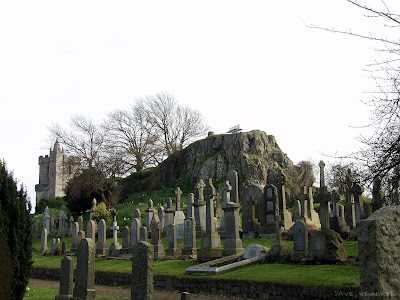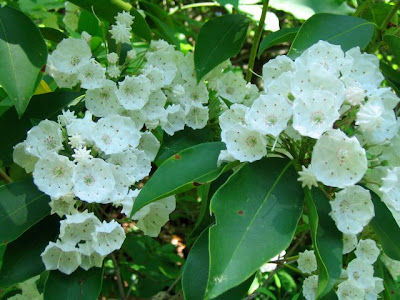
Healing landscapes
Morton Arboretum’s New Children’s Garden
October 12, 2009

Nature Makes Us Nicer!
October 6, 2009

Image courtesy of Sarah Olmsted at Imagine Childhood
Nature makes us nicer. And more community-oriented. And more generous. I know, some of you are thinking “Duh-uh, we knew that all along.” Well, now you have your proof.
A new study by the University of Rochester found that even after just looking at pictures of nature, people felt closer to their community, were more willing to give money to a charitable cause, and cared more about social outcomes than they were after looking at “man-made” scenes. Researchers explain that connecting to nature also helps people to connect to their basic good values. Just imagine how much more exponentially multiplied the results would be if people were to experience nature in person rather than just by looking at pictures. See the Treehugger article for the full story.
So go on, pat the bunny! Imagine Childhood is one of the Therapeutic Landscapes Network’s Wonderful Sponsors. Visit their website and show them some love. The have all sorts of wonderful things to make the most of you and your kids’ outdoor experience, and Sarah’s blog is filled with beautiful images of nature. One of these days, I’m going to buy the same camera that she has.
And if you’re feeling generous after reading this post, donate to the TLN. We will put your gift to good use! Here’s another picture for inspiration:
Full citation: Weinstein, Netta, Richard Ryan, and Andrew Przybylski (2009). “Can Nature Make Us More Caring? Effects of Immersion in Nature on Intrinsic Aspirations and Generosity.” Personality and Social Psychology Bulletin, October, Vol. 35: pp. 1315-1329.
Live! Therapeutic Landscapes Network Launches New Site, HealingLandscapes.org
September 29, 2009
The Therapeutic Landscapes Network is pleased to announce the launch of our new website.
- Search function within the site;
- Blog and site under one virtual roof;
- Larger, richer images, with more on the way;
- Updated Designers and Consultants Directory with a map for geographic as well as alphabetical search (contact us if you’d like to be added to our Directory);
- Expanded Therapeutic Gardens Directory (map coming soon, too);
- Sponsors who help fund the work that we do (individual donations are also most welcome);
- Sound! Click on “play birdsong audio” on the left-hand side of the home page;
- And coming soon, a Network Forum within the site for members to share information and ideas.
Essential Design Elements for Therapeutic Gardens
September 28, 2009
On the the first day of the ASLA Conference in Chicago this year, I went on a Field Session where we toured three therapeutic gardens in three different locations. It was a great day, and I’ll be blogging more about that soon.
Interview with Dr. Esther Sternberg, Author of Healing Spaces: The Science of Place and Well-Being
September 16, 2009
Esther M. Sternberg, M.D. is the author of a new book, Healing Spaces: The Science and Place of Well-Being (Belknap Press/Harvard University Press). The book has been reviewed extensively by a broad range of publications and blogs. So rather than write yet another review, I asked Dr. Sternberg for a telephone interview to discuss some the topics specific to landscapes and health. Before joining the National Institutes of Health, Dr. Sternberg was on the faculty at Washington University in St. Louis, MO. She is also the author of The Balance Within: The Science Connecting Health and Emotions, is a regular book review contributor to Science magazine, and lectures nationally and internationally for lay and scientific audiences. You can learn more about Dr. Sterberg on her website, www.esthersternberg.com, and you can watch an author interview here. Many thanks to Dr. Sternberg for this illuminating conversation.
Who was your audience for this book? Everybody! This is a crossover book, meaning that it’s for everyone from scientists to “educated laypeople” – non-scientists, anybody who might want to find a healing space. It’s also for architects, designers, students, and other young people – which is why I used more populist language, metaphors, and examples. One of the crucial steps in bridging different disciplines is learning each other’s language. The book has been favorably reviewed across a wide spectrum of journals, magazines, and blogs, from The Lancet, The Scientist, and New Scientist to the L.A. Times and New York Times, to People magazine – which tells me that the book has been successful in reaching a broad audience.
You refer in your book to Roger Ulrich’s seminal “View from a Window” study that was published in Nature in 1984, which made the scientific community take notice of environmental psychology as more than just a “soft science.” Since then, Ulrich and colleagues have been documenting the physiological effects of people’s experience of nature by measuring blood pressure, heart rate, temperatures, etc. How have recent technological advances in neuroscience changed the ways that research on environmental influences is carried out? There are two kinds of research in this area: First, studying whether something works (and under what circumstances), and second, studying how it works. Ulrich’s ‘View from a Window’ and other clinical studies are the former, and neurosience focuses more on the latter. We may already know that people benefit from being in or looking out onto a garden. But why, and how? Is it the light, the color, the movement, or something else? We can now use technology such as MRIs, PET scans, and other brain imaging to try to answer those questions, and to try to tease out which environmental factors are creating which responses.
Is stress reduction the primary reason that passive experience of nature (rather than active experiences, like gardening or exercise) is restorative? Or is there some other way that it is also beneficial? There are two ways that nature (and other environmental factors) can have beneficial outcomes. First, yes, by reducing stress and its negative effects; stress itself does not cause disease, infections, and so on, but it reduces the body’s resistance to illness and disease, harmful viruses and bacteria. So reducing stress can help foster health and healing. But there’s a second important way that nature works: By enhancing the positive. Positive sensory experiences trigger positive responses and reactions. They turn on parts of the brain that are rich in endorphin receptors (and endorphins make us feel good). We can’t actually measure the level of endorphins in a person’s body, but through brain imaging we can see that parts of the brain that are rich in endorphin receptors become active when there is positive stimulus, such as seeing a beautiful vista, or smelling a fragrant plant, or hearing birdsong. Therefore, we can assume that more endorphins are being released. And perhaps this is why gardens and other natural landscapes are so restorative: They provide a multisensory experience in which more than one positive response is triggered – light, color, sound, scent, touch – all combine to a create a rich positive experience.
Can neurological studies now “prove” theories such as those by Stephen and Rachel Kaplan? They argued that we are less stressed by nature than we are by, for example, being on a crowded city sidewalk, because nature elicits “soft fascination” rather than the extreme concentration needed in less naturalistic environments. Yes, theories like the Kaplans’ make sense on a neurological level, because different parts of the brain are activated when you are in a threatening vs. a non-threatening “focused attention” situation. A non-threatening situaton is less emotionally charged, thus requiring less vigilance. In the book, I use the analogy of the maze vs. the labyrinth. The maze is stressful. We don’t know how to get out, we have too many choices, we might get trapped inside – the body’s stress hormone axis [see pg. 98] kicks into high gear. But with a labyrinth, you are not faced with stressful choices. You enter and exit through one point, you can see the whole thing, and you are led on a simple, calming path.
Has any research been done yet on the effects of people walking labyrinths? Not yet. Probably the closest is Eduardo Macagno and Eve Edelstein’s study at UCSD using StarCAVE technology (virtual reality) combined with measuring brain activity through EEGs to study how people negotiate space. In one study, they found that in navigating a building without the usual landmarks, people who could see light and shadow were still able to navigate. When those clues were taken away, people lost their ability to find their way. This kind of study may be able to help with discovering better wayfinding clues for hospitals and nursing homes, even for people with Alzheimer’s and other forms of dementia.
All of it is fascinating and it’s very important for general health, for maintaining health, and for personal health. A lot of data out there in neuroscience research tells us that place matters. We are affected by our environment, and if we manipulate our surroundings to reduce stress and to provide positive responses, we will benefit.
Almost there! Therapeutic Landscapes Network gears up to launch new website
September 11, 2009
- improved searchability and richer imagery;
- an expanded Designers and Consultants Directory;
- an expanded Directory of Therapeutic Gardens;
- sponsorship opportunities for businesses and organizations to promote their products, services, and expertise;
- an integrated blog (website and blog all under one virtual roof);
- an interactive Network Forum where members can meet and share information and ideas;
- and more information than ever before on gardens, landscapes, and other green spaces that facilitate health and well-being, for an even broader global community of designers, health and human service providers, educators, students, gardeners, and nature enthusiasts.
- Email us at info@healinglandscapes.org if you’d like to list in our Designers and Consultants Directory or be one of our fabulous sponsors.
- Sign up here (or with the form in the right-hand column – same thing, different look) to become a member and get on our mailing list. It’s free, and we’ll put you on our newsletter list so we can tell you right away when we launch the new site.
The High Line: A “Landscape for Health”
July 24, 2009





Mountain Laurel and Russel Wright
June 6, 2009
New ASLA Professional Practice Network: Children’s Outdoor Environments
March 31, 2009
“Landscape architects play a critical role in advocating and designing a variety of places for children to play, learn, and develop a relationship with the natural environment to carry with them into adulthood and citizenship. The movement to (re)connect children with nature has been steadily growing and gaining momentum.
In a time when children, on average, spend 45 hours a week “plugged in” and less than 30 minutes a week in outdoor unstructured play, our profession has no option but to act.
Landscapes of Remembrance: Cemeteries as Healing Landscapes
March 20, 2009

Image of Stirling Cemetery in Scotland courtesy of The Daily Undertaker, an interesting blog about love, grief, and remembrance.
Cemeteries as healing landscapes? I can just imagine some the comment: “Um, I hate to break it to ya, but those folks are, well, you know, beyond healing.” Sure, cemeteries are for people who have died. But just as much, they are for the living: We plan them, bury and visit our family and friends in them, and maintain them – individual gravesites, family burial plots, and cemeteries as a whole. People also visit cemeteries as parks – more on that in a bit. Grief is one of the most painful of human emotions, and mortality is one of most people’s greatest fears. Nevertheless, cemeteries can be powerful landscapes not just as sites to inter the dead but as places for us to grieve, remember, and even celebrate life. All of these life-affirming actions contribute to our health and well-being.

Maya Lin's Vietnam Veterans Memorial in Washington, D.C.
For years, I’ve thought of memorials as healing landscapes, and there’s a page of the Therapeutic Landscapes Network devoted to memorials. They serve as reminders and touchstones for the living to remember people and events. But it wasn’t until recently, when a local cemetery board contacted me about a design job, that I started to think of cemeteries (or what we called graveyards in the no-nonsense New England village where I grew up) as healing landscapes. They both serve as landscapes of remembrance, catalysts for individual and collective grieving and memory.
Frederick Law Olmsted, “the father of landscape architecture,” was inspired to create public parks in urban areas after learning that people were spending their Sundays at Mt. Auburn Cemetery because it was the only park-like setting within close reach of the city. Olmsted also designed some beautiful and historically significant cemeteries, including Mountain View Cemetery in Oakland, CA. When I was in graduate school at UC Berkeley, I used to visit Mountain View; I had no connection to the people buried there, but it was a beautiful, quiet, serene landscape for walking and thinking.
There are millions of cemeteries, of all different kinds, in all different places. Some are sad and bleak, some are beautiful and park-like, some are tourist destinations for famous people (Elvis, John Lennon, J.F.K. – there are even celebrity gravesite tours) or just for themselves (Arlington National Cemetery, the “Cities of the Dead” in New Orleans). Many reflect a time period, place, and culture. My father-in-law’s ashes are buried at Colney Wood Natural Burial Park, one of a growing number of natural burial parks in Europe (we’ve got a few in the U.S., too – see The Centre for Natural Burial for more information and lists of sites). Not a religious man, he did not want his remains to be buried in a church graveyard; but my family wanted to have a place we could visit – a beautiful place that he would have liked to walk in and that we would be comforted by visiting. Colney Wood is just that: A lovely forest that is also a cemetery. We chose a spot under a majestic multi-trunk chestnut tree (two images, below), and we continue to take comfort from the place.
 As for me, I’ve got a plot picked out in the small town where I grew up. It’s a rural spot, surrounded by trees and grass and old New England stone walls. I’m hoping it’ll be a long time until my relatives have to think about that, but there’s comfort in knowing that when the time comes, they’ll be able to wish me goodbye and visit me in a landscape that continues to give solace even after I’m gone.
As for me, I’ve got a plot picked out in the small town where I grew up. It’s a rural spot, surrounded by trees and grass and old New England stone walls. I’m hoping it’ll be a long time until my relatives have to think about that, but there’s comfort in knowing that when the time comes, they’ll be able to wish me goodbye and visit me in a landscape that continues to give solace even after I’m gone.









